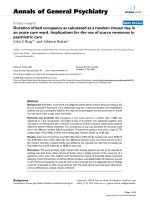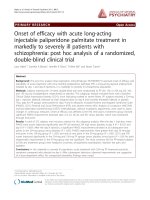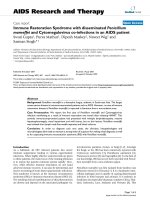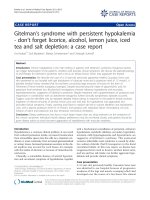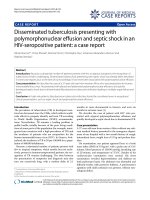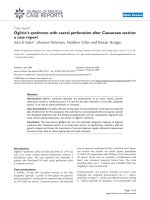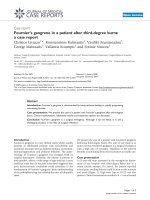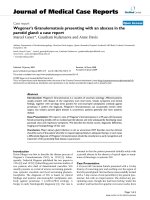Luận án TS y học: Patient’s satisfaction with health services at Kuta Blang health center in Bireuen district, Nanggroe Aceh Darussalam province, Indonesia
Bạn đang xem bản rút gọn của tài liệu. Xem và tải ngay bản đầy đủ của tài liệu tại đây (1.1 MB, 84 trang )
PATIENT’S SATISFACTION WITH HEALTH SERVICES
AT KUTA BLANG HEALTH CENTER IN BIREUEN
DISTRICT, NANGGROE ACEH DARUSSALAM
PROVINCE, INDONESIA
NAZIRAH
A THESIS SUBMITTED IN PARTIAL FULFILLMENT OF
THE REQUIREMENTS FOR THE DEGREE OF
MASTER OF PRIMARY HEALTH CARE MANAGEMENT
FACULTY OF GRADUATE STUDIES
MAHIDOL UNIVERSITY
2008
COPYRIGHT OF MAHIDOL UNIVERSITY
ACKNOWLEDGEMENTS
This thesis would not have been possible without the help and support of many
people. First of all, I would like to thank the Provincial Health office, of Nanggroe Aceh
Darussalam, for giving me this opportunity to study in the Faculty of Primary Health Care,
Mahidol University, and AIHD. Without their faith in my capacity, I would not have been
able to partake in this course and gain knowledge in Primary Health Care Management.
My heart felt gratitude goes to Assoc. Prof. Jirapon Chumpikul Ph.D., my major
advisor, who through out entire project period was tireless to impart her knowledge of
research to me and made a success.
Prof. Santhat Sermsri, Ph.D., was my co-advisors and they contributed many useful
points during the research project relating to methodology and statistical analysis, and made
the study easy and enjoyable. My heartfelt thankfulness is also extended to my external
advisor, Dr. Ratanotai Pluburukarn, Dip. Thai Board of Pediatrics, for her beneficial as well
as practical suggestions and coments offered during the thesis defend. I express my thanks
to DHS1- ADB Loan INO Dinkes Prov. NAD.
My special thanks to all the Faculty of Primary Health Care Management, Mahidol
University, AIHD, for arranging all the necessary formalities and clearances required to
complete the research thesis. Unless I had chance to be here, I would never have met the
pleasantly energetic staffs working in this institute, especially Ms. Sirilac Lyeskul, a tiny
lady whose heart full given to M.P.H.M. course. I would like also thanks to head of Kuta
Blang health center and all staffs for their encouragement and support to make this piece of
work successful. Last but not least, I would like to thank my beloved husband Mr. Faisal
and my lovely children M. Khalil Al Wafi and Wifa Ufairah Hj for their kind patience and
support during the study period, and also to my loving mother, sisters and brothers for their
endless love and caring that helped me flourish during my study in Thailand. My concern
and memories to all collogues for their guidance and support. Thank you very much for
making me always says, “How fortunate I am!”
Nazirah
Fac. of Grad. Studies, Mahidol Univ. Thesis/iv
PATIENT’S SATISFACTION WITH HEALTH SERVICES AT
KUTA BLANG HEALTH CENTER IN BIREUEN DISTRICT, NANGGROE
ACEH DARUSSALAM PROVINCE, INDONESIA
NAZIRAH 5037994 ADPM/M
M.P.H.M. (PRIMARY HEALTH CARE MANAGEMENT)
THESIS ADVISORS: JIRAPORN CHOMPIKUL, Ph.D., SANTHAT SRERMSRI, Ph.D.
ABSTRACT
This cross sectional study was conducted to assess the levels of patient satisfaction
with services and to identify factors relating to patient satisfaction at Kuta Blang health
center in Bireuen District, Aceh Province, Indonesia. The dependent variables of patient
satisfaction toward services were measured in terms of convenience, courtesy, quality of
care and physical environment. Using a self-administered questionnaire, data were derived
from 200 patients who came to OPD services, aged 15 to 60 years old, from 6
th
January to
28
th
February 2008. Data were collected regarding socio-demographic factors, accessibility,
distance, waiting time for services, information received, expectation regarding OPD
services and patient satisfaction. Chi-square test was performed to analyze the association
between dependent and independent variables.
The results concluded that the overall satisfaction was 23%. The patients were most
satisfied with courtesy (38%) while least satisfied with convenience (18%). There were
statistically significant associations between occupation, waiting time for physician,
expectation level and visiting the health center service again (p<.005).
The findings of this study are important for understanding levels of satisfaction and
milestones in improving the quality of OPD services at health centers. Most patients, in
their comments and suggestions, highlighted the needs to improve the discipline of health
care workers encourage training programs for health providers, and provide the continuing
education for the experienced health providers to keep up with updated knowledge,
technology and work practices.
KEY WORDS: PATIENTS SATISFACTION/ HEALTH CENTER
74 pp.
CONTENTS
Page
ACKNOWLEDMENTS iii
ABSTRACT iv
LIST OF TABLES vii
LIST OF FIGURES viii
LIST OF ABBREVIATIONS ix
CHAPTER
1 INTRODUTION
1.1 Rational and Justification 1
1.2 Research question 5
1.3 Research objective 5
1.4 Conceptual framework 6
1.5 Variables and operational definition 7
1.6 Limitation of the study 9
2 LITERATURE REVIEW
2.1 Background information about health center 10
2.2 The definition of satisfaction 11
2.3 Literature regarding independent variable 13
2.4 Theoretical conceptual framework 19
2.5 Components of satisfaction 21
3 RESEARCH METHODOLOGY
3.1 Research design 24
3.2 Population and study site 24
3.3 Sample size and sampling technique 25
3.4 Data collection tools and .methods 26
3.5 Content validity and reliability 27
vi
CONTENTS (Cont.)
Page
3.6 Research instrument for data collection 27
3.8 Data analysis 28
4 RESULTS
4.1 Socio-demographic characteristics of the patients
4.2 Accessibility characteristics of the patients
4.3 Patient’s expectation with health cervices at OPD Kuta Blang health center
30
32
35
5 DISCUSSION
5.1 Methodological concern
5.2 Socio-Demographic characteristics
5.3 Patient accessibility towards health cervices
5.4 Patient’s expectation towards health services at OPD
5.5 Patient’s satisfaction towards health services
47
48
49
50
51
Discussion 47
6 CONCLUSION AND RECOMMENDATION
6.1 Conclusion 53
6.2 Recommendation 54
REFERENCES 61
APPENDIX 62
BIOGRAPHY 74
LIST OF TABLES
Table Page
1 Reliability coefficient……………………………………………………… 27
2 Number and percentage of respondents by Socio-demographic characteristics……….31
3 Number and percentage distribution of the respondents classified by
accessibility……………………………………………………………………… 33
4 Overall expectation of patient towards health services at the OPD
Kuta Blang health center…………………………………………………… 35
5 Number and percentage of patient health problem………………………… 37
6 Percentage of the respondents patient satisfaction towards OPD service
regarding convenience……………………………………………………… 38
7 Number of percentage of patient satisfaction towards OPD service
regarding courtesy……………………………………………………………… 38
8 Percentage of the respondents by patient satisfaction towards OPD service
regarding quality of care…………………………………………………………39
9 Percentage of the respondents by patient satisfaction towards OPD service
Regarding physical environment………………………………………… 40
10 Total score of overall satisfaction each component…………………………….40
11 Level of satisfaction with health service of the outpatient of Kuta Blang
Health center……………………………………………………………………41
12 Explanatory factors associated with satisfaction……………………………….42
13 Explanatory factors not associated with satisfaction………………………… 43
14 Percent distribution of patient’s suggestion for improving the quality
of health center at OPD Kuta Blang health center……………………… 45
15 Number and percentage distribution of the respondents who would
visit the health centre again……………………………………………………46
LIST OF FIGURES
Figure Page
1. Conceptual framework 6
2. Patients flow of service in Kuta Blang health center 17
3. An Emerging Model-Phase 4 20
LIST OF ABBREVIATION
NAD : Nanggroe Aceh Darussalam
OPD : OUT-patient Department
WHO : World Health Organization
MoH : Ministry of Health
Fac. of Grad. Studies, Mahidol Univ. M.P.H.M. (PHC Management) /1
CHAPTER 1
INTRODUCTION
1.1 Rationale and justification
With globalization has come an alarming increase in international statements
and guidelines for developing about ethics, equity and health system reform. When it
does not refer to specific places, times, people and condition, such thinking is of little
interest international forum. All these trends in fact make the importance of the local
of district health system more conspicuous. Within that system, health development is
most effectively implemented through health centers, if health personal understand
these to have responsibility both for maintenance of optimum health and for care of
the sick in a given area population (1).
Patient’s satisfaction is a component of health care quality and is increasingly
being used to assess medical care in many countries in the world. Until recently,
traditional assessments of medical care were done purely in terms of technical and
physiological reports of outcomes. It is an established fact that satisfaction influences
whether a person seeks medical advice, complies with treatment and maintains a
continuing relationship with practitioners (2).
Patient satisfaction has long been considered an important component when
measuring health outcomes and quality of care. The rising strength of consumerism in
society highlights the central role patient’s attitudes play in health planning and
delivery. Further more, a satisfied patient is more likely to develop a deeper and
longer lasting relationship with their medical providers, leading to improved
compliance, continuity of care, and ultimately better outcomes (3).
Nazirah Introduction /2
Medical care aims not only to improve health status but also to respond to
patients need and wishes and to ensure their satisfaction with care. Likewise,
conducting surveys to measure satisfaction with psychometrically validated
questionnaires entails assessment of the quality of care organization and procedures.
Patient judgment on medical care also contributes to medical outcome. In the case of
ambulatory care, it has been clearly shown that satisfied patients are more likely to
cooperate with treatment, to maintain a continuing relationship with a practitioner and
thus enjoy a better medical prognosis. From a conceptual point of view, the construct
of patient satisfaction as been defined by Isabell Gasquet Ware (4). As an "attempt to
capture the personal evaluation of care that cannot be known by observing care
directly" and to “Good” consider opinion of patients as a multidimensional subjective
indicator of quality of care. The model most commonly, though implicitly, used in
satisfaction work is the discrepancy model (degree of fulfilment of expectation is
related to satisfaction level) giving to patient expectations a central role. This model,
according to Sitzia “implies that concentrating upon areas of expressed dissatisfaction
is more valuable than obtaining consistency of expressed satisfaction". In France,
measuring satisfaction has been mandatory since 1996 and several questionnaires
have been developed to evaluate inpatient care. Most existing outpatient satisfaction
questionnaires have been developed to assess primary care practice, especially general
practice. However, it could be hypothesized that content of questionnaires evaluating
primary care physician may be different from that of questionnaires exploring hospital
consultation with a specialist because of differences in patient expectations. So it
could be assumed that dimensions that are very important in the case of primary care
like human qualities of the physician and medical information could have a lesser
importance in case of hospital consultation, while technical competency could have a
more important place (5).
The quality of health services can be measured by a community's level of
satisfaction in terms of the health services received, both curative and preventive (6).
The quality of health services is very much influenced by the quality of physical
facilities, types of work force available, medicines, health instruments and other
Fac. of Grad. Studies, Mahidol Univ. M.P.H.M. (PHC Management) /3
supportive facilities, services conferring process, and compensation received and the
expectation of the consumer society. Hence the increase in physical quality and
aforementioned factors are preconditions to be fulfilled. Afterwards, the process of
services conferral is to be increased through increase in quality and professionalism of
health resources as stated above. While the expectation of the consumer society is
being adjusted through improvement in general education, health information, good
communication between health providers and the public (7, 8).
As the center for basic health services at the sub district level, each health
center (community healthcare centers) generally has a doctor who is appointed as the
head of the health center. However, the administrative duties of a health center head
often reduce consultation time with patients. As a result, patients are mostly taken
care of by nurses and midwives. This is a dilemma. On one hand, as a doctor assigned
to a particular health center, he or she is required to contribute to the provision of
health services, but on the other hand, the administrative duties of a health center head
in fact interrupt their duties as a doctor (6).
The health plan at provincial level emphasizes patient focused service
improvement and organization development. The rate of patient satisfaction at 80% is
the minimum goal for every hospital to achieve in Thailand (9). Indonesia health care
delivery system consists of network of primary, secondary and tertiary facilities. An
essential feature of health centers which operate at first level is the main contact
among community. Based on vision of health Indonesia in 2010, 80% of health
centers did not provide good quality of services (8).
Health centers in Indonesia are designed to provide comprehensive, integrated
health services; these include curative, promotive and preventive care, and
community-based rehabilitation. There are also responsible for health development in
their respective catchments area through community activities and innovative
approaches. Depending on the population density, geographical area and local
infrastructure, a health center catchments area is either a sub district or a Part of one.
Each health center serves an average population of 30,000. They operate under the
Nazirah Introduction /4
administrative authority of district administration and the district health office. The
function of health center is expended through several subordinate units that include
sub-center, posts for trained midwifes in village, and subordinate unit that integrated
services unit (posyandu). This health center was linked to the “Village Community
Resilience Body” (LKMD) to support village-based development activities (10).
Patient’s satisfaction and its measurement are important as other clinical
health measures and primary means of measuring the effectiveness of health care
delivery as well as for policy analyst, health care managers, practitioners and users.
Environment has forced health care organization to focus on Patient’s satisfaction as a
way to gain and maintain market share. If you don’t know what your strengths and
weakness are, you can’t compete effectively. Despite problem with establishing a
tangible definition of “satisfaction” and difficulties with measurement, the concept
continues to be widely used. In many instances when investigators claim to be
measuring satisfaction, more general evaluation of health care services is being
undertaken (11).
Bireuen is the youngest district in NAD (Nanggroe Aceh Darussalam) by the
rule UU No. 48 on October 1999, before it was apart of North Aceh. The total area is
1.901,021 km
2
consist of 17 sub district, and 581 villages. The total population is
365.184 and until 2006, Bireuen district has 17 health centers, and 5 out of 17 health
centers have beds for patients having serious illness. To provide services total of 142
staffs with one doctor, one nutritionist, one nurse secretary, one nurse for
communicable disease ,one pharmacy assistance and for each village have one
midwives and total of 40 for whole villages. The main programmes conducted in
health center were focused on mother and chid health, immunization, nutrition,
communicable diseases, health environment and health promotion and prevention. By
National policy, a health center serves an average population of 30,000 (12, 13).
Kuta Blang health center is one of the rural health centers in Bireuen sub district,
which responsible for 40 villages with 20.006 populations and the average of patients visit
were 60 patients per day. Health center provides free medical services to all the peoples in
Fac. of Grad. Studies, Mahidol Univ. M.P.H.M. (PHC Management) /5
the village. There has been no study on patient satisfaction since the center was established;
to improve quality of health care in this area the result of measuring patient’s satisfaction
could be used for starting point to improve quality of services in Kuta Blang health center.
A better understanding about factors relating to patient’s satisfaction can help policy and
decision makers to implement programs adapted to patient’ need as perceived by patients
for all health centers in Bireuen district. Therefore, this patient satisfaction study was
conducted at Kuta Blang health canter, in Bireuen Aceh Province, Indonesia (12, 13).
1.2 Research questions
What are factors related to patient satisfaction toward the health care services at
Kuta Blang health center in Bireuen district?
1.3 Research objectives
1.3.1 General objective
To assess the levels of patient satisfaction with the services and to identify
factors relating to the patient satisfaction.
1.3.2 Specific objectives
1. To describe patient satisfaction at Kuta Blang health center in Bireuen district.
2. To describe socio-demographic factors of patient on satisfaction at Kuta Blang
health center in Bireuen district.
3. To assess the accessibility of Kuta Blang health center.
4. To asses the expectations of service at the health center according patient
perception at Kuta Blang health center.
5. To determine the relationship between patient’s characteristics, expectation on
services system, accessibility to the service and patient satisfaction to the service
at Kuta Blang Health Center in Bireuen District, Aceh Province, Indonesia.
Nazirah Introduction /6
1.4 Conceptual framework
Independent variables Dependent variable
Figure 1 Conceptual framework
Predisposing Factors
Socio-demographic factor
- Age
- Gender
- Marital Status
- Educational
- Occupation
Enabling factor:
Family Income Accessibility
- Distance
- Waiting time for services
- Information received
- Service hour
Need factors
Expectation of patients
about services
- Physical facilities
- Doctor services
- Nurses services
- Pharmacist services
- Registration staff
services
- Waiting time
Health problem
Patient’s satisfaction
toward services at Bireuen
health center
- Convenience
- Courtesy
- Quality of care
- Physical environment
Fac. of Grad. Studies, Mahidol Univ. M.P.H.M. (PHC Management) /7
1.5 Variables and operational Definition
1.5.1. Independent variable
Socio-demographic characteristics consist of age, gender, marital status,
education, and occupation.
Age refers to the age of the respondent at the time of interviewing, including
age, 16-60 years old. The limit of age at 60 because age 60 is an old person who is
still easy to communication but the age beyond 60 is probably too old to provide clear
information.
Marital status has five categories, is namely single, married, separated,
widowed and divorced.
Educational level refers to the obtainment of schooling education of the
patients. In this study education levels are categorized in 5 groups, No
education/illiterate, primary school, high school, college/university, and other.
Occupation is defined as the main job of the respondents categorized in 7
groups: 1. Housewife/unemployed, 2. Government service, 3. Farmer, 4. Merchant/
self-employer, 5. Laborer, 6.Unemployed and 7.Others.
Accessibility to cervices means how comfortable it is to access the services in
terms relevant to information received, waiting time and service hour.
Distance means the length of travel time, and expense to health center and
convenience location health center to come.
Waiting time for services means an opinion of patient towards waiting time
for each section service at Kuta Blang health center such as, registration room,
physical examination, treatment room, and pharmacist room.
Information received means type of the information about health center
including regulation, illness, drug use, health promote and preventive care.
Family income is an approximate real income of the family in month. Persons
are given an open-ended question to indicate the month of family income.
Nazirah Introduction /8
Physical facilities mean an opinion of patient towards general appearance of
building, place, chairs, desks, and toilet.
Doctor’s service means the services provided by the health personnel, mine,
physician. The doctor’s service is to provide treatments, including taking care of
patients of the health center. It is assumed that patient can evaluate doctor’s skills and
understanding of results of the treatment.
Nurse’s services means the service provided by the nurse who are working in
health center. The patient can consider from ability and experience of the nurse,
suggestion of how to take care of oneself, clarification diagnosis and care, and
character.
Pharmacist services mean the service provided by the pharmacist staff in the
drug units.
Registration’s staff’s services mean the service provided by the registration
staff in the registration room.
Waiting time means opinion of the patient towards the amount of waiting
time for service at Kuta Blang health center.
Health problems refer to the health condition and current illness that brought
the patient to the health center.
1.5.2 Dependent variable
Patient satisfaction: refers to the patients’ state of being satisfied with health
care services at the out-patient Kuta Blang health center. Patient refers to the
respondents who consume the health services at the OPD of the health center during
the time of conducting interviews. The indicators for client’s satisfaction in this study
consist of four components convenience, courtesy, quality of care and physical
environment.
Convenience: In this study, it means accessibility of health services, taken
care well and also includes sufficiency of physical facilities.
Fac. of Grad. Studies, Mahidol Univ. M.P.H.M. (PHC Management) /9
Courtesy: Means manners, speaking, and friendliness of provides by health
personnel.
Quality of care: means quality of service in all levels from the patient. The
quality includes capability of doctors to diagnose correctly and medical treatment,
nursing skill, and use technology facilities services.
Physical environment refers to features of the physical setting in which the
health services are provided. Cleanliness of equipment and cleanliness of the space as
health center.
.
1.6 Limitation of the study
This study is concerned at the sub-district of Bireuen district. It is there for not
reflect the whole health care service of the district level. The information obtained
from the study population might have some variations and this study is conducted
with limited resources making it impossible to include many important questions and
variables.
Nazirah Literature Review /10
CHAPTER 2
LITERATURE REVIEW
The literature review included the following topics:
- Background information about health center
- The definition of Satisfaction
- Literature regarding to independent variables
- Theoretical conceptual framework
- Components of satisfaction
2.1 Background Information about Health Centers
A health center is a functional health organization unit which server as a center
for health development, community participation development, besides providing
comprehensive and integrated health service to the community within working area. It is
authorized and responsible for delivering health care service to the community within its
working area, which is a sub district or a part of sub district (16).
Health center as a part of district health system is administratively
responsibility of the head of district health office, but technically responsible to the
MoH. Health center as a part of national health system is a part of basic health care
level in the referral system (17).
Health center is the spearhead of the national health system and one of leading
element for national health development. Basic health services provided at health
center are: 1. Medical Treatment; 2. Health Promotion; 3. Environmental Health;
4. Maternal and Child Health; 5. Nutrition; 6. Communicable diseases (17).
Fac. of Grad. Studies, Mahidol Univ. M.P.H.M. (PHC Management) /11
At present, the following specific targets related to basic health care services
at health centers, consolidated in the government’s health policy program, are being
implemented under Indonesia’s new national development policy, known as
PROPENAS (fiscal 2000-2004).
- Prevention of the outbreak and spread of infectious diseases.
- Reducing the instance of infection, mortality, and disease-induced disability
- Extension of areas with access to basic medical services, plus more
equitable access.
- Enhanced impact and efficiency of basic medical and related services
- Promotion of the use of safe and effective pharmaceuticals through medical
services and medical networks, as well as of traditional forms of treatment (18).
Health center effort consist of community health service, which focus on
promotive and preventive with community group approach through outreach health
service. Basic medical service, which focus on the curative and rehabilitative service
with individual and family approach through outpatient and referral services. In
certain condition and if it is possible, we can consider that health can provide
inpatient services as interval before to hospital (16).
Health care has many changers over the years. The objectives of health care
changed with the requirements of society and the availability of resources and
technology. The WHO conference on supporting health for all, held in 1990, defined
future development in health to be human centered. A lot of stress has been made on
investment in heath, patient care and patient’s right to delivery of quality health care
leading to patient satisfaction (19).
2.2 The definition of satisfaction
Based on dictionary, the definition attributes the term “satisfaction” to the
Latin root sati’s meaning “enough”. Something that satisfies will adequately fulfill
expectation, need or desire, and giving what is required, leaves no room for
complaint.
Nazirah Literature Review /12
Two points arise from this definition. First, a feeling of satisfaction with a
service doesn’t imply superior service; rather that adequate or acceptable standard
was achieved. Dissatisfaction is defined as discontent, or failure to satisfy. It is
possible that consumer is satisfied unless something untoward happens, and
dissatisfaction is triggered by critical event. Secondly, satisfaction can be measured
only against individual’ expectation needs or desires. It is a relative concept:
something that make one person satisfied (adequately meets their expectation) may
make another dissatisfied (fall short of their expectation) (11, 2).
Patient’s satisfaction is an expression of the gap between the expected and
perceived characteristics of a service. Satisfaction is a subjective phenomenon and
could be elicited by asking simply how satisfied or not patients may be about the
service. However, it has been found that, questionnaires that ask patients to rate their
care in terms of how satisfied they are tend to elicit very positive ratings that are not
sensitive to specific processes that affect overall quality. It is recommended that
patients be asked to participate on their experiences through specific questions (2).
Patient reports about satisfaction with care are thought to reflect attitudes and
opinions about care that may influence other patient behaviors, such as choice of
providers, amount of services used, and compliance. In addition, patient satisfaction
reports are behaviors in their own right (20).
Satisfaction, like many other psychological concepts, is easy to understand but
hard to define. The concept of satisfaction overlaps with similar themes such as
happiness, contentment, and quality of life. Satisfaction is not some pre-existing
phenomenon waiting to be measured, but a judgment people form over time as they
reflect on their experience. A simple and practical definition of satisfaction would be
the degree to which desired goals have been achieved. Patient /Patient’s satisfaction is
an attitude – a person’s general orientation towards a total experience of health care.
Satisfaction comprises both cognitive and emotional facets and relates to previous
experiences, expectations and social networks. Meredith and Wood (1995) have
described Patient’s satisfaction as ‘emergent and fluid’. It also has been important
Fac. of Grad. Studies, Mahidol Univ. M.P.H.M. (PHC Management) /13
factors influencing patients/Patients in this regard include literacy levels, intellectual
and physical/sensory disability levels and difficulties with language proficiency or
ethnic and cultural diversity. Social elements within our society must be considered as
they can very often dictate whether the consumer will provide feedback and express
their satisfaction or otherwise, e.g., financial status, educational status, demographics
(urban/rural), technology. Previous measurements of Patient’s satisfaction overwhelmingly
show that the majority of consumers, usually 80 % or more, express overall satisfaction
with their care, with few respondents responding negatively to any given item. Satisfaction
is, however, a relative measure which research literature shows, may be influenced by
many factors that should be considered (21).
2.3 Literature Regarding To Independent Variables
2.3.1 Socio-demographic characteristics
Socio-demographic variables are related to all kinds of health care
experiences that patients have, and the way that they interpret them. For instance,
better educated patients may participate in diagnosis and treatment decisions more
then less educated patients but remain less satisfied with their degree of participation
because physicians are not meeting their higher expectation. Consequently, it is often
difficult to interpret findings of relationships between socio- demographic and
satisfaction (22).
Many researchers documented that socio-demographic variables are directly
related to patient satisfaction. Similarly, patient satisfaction correlates to health
personal behaviour, especially those who have low income. These variables are well
documented by many different researchers and writers. Perhaps the most consistent
determinant characteristic is age, with a body of evidence from various countries to
suggest that older people tend to be more satisfied with health care than younger
people (23).
The other side of the of the “consensus coin” is the existence of consistent,
coherent differences within demographic segments of a population. A fourth task for
Nazirah Literature Review /14
future health behaviour research is the determination of how various groups within a
population differ in their definition. Systematic study of diverse samples, of persons
with different ethnic, education, socioeconomic or age characteristic, might reveal
demographic diversity that would have important practical value in increasing the
success of programs and improving communication between professionals and
clients (20).
The study in health center, Bangkok Metropolitan Administration found the
associations between socio-demographic-economic factors and patient satisfaction.
The results showed that education, family income, travelling time and transportation
of respondents to visit health center last year had significant associations with degree
of satisfaction (24).
It is commonly believed that satisfaction with health care may be dependent
upon variables as social class, marital status, gender, and-in particular age. Socio-
demographic characteristics were concluded to be at best a minor predictor of
satisfaction (25).
2.3.2 Accessibility to Health Center
The accessibility of health care can be assessed in various aspects: the
possibility for residents to see their doctor; to use the services of health care system;
the provision of population with health care resources (doctors, nurses). The
evaluations of the health center territorial accessibility also depended upon the
patients’ residence and the type of health center.
When estimating the accessibility of health care it is important not only how
long do the patients spend at the reception but also how long do they have to wait
outside their doctor’s consulting-room. According to the data of the survey one-third
(32.9%) of the patients think that they have to wait too long for the visit to their
doctor. The results of the logistical regressive analysis have shown that the patients’
estimations on the time spent at the reception were largely related to the patients’
education, residence, the frequency of visits, and the type of health care. The
Fac. of Grad. Studies, Mahidol Univ. M.P.H.M. (PHC Management) /15
probability that people with vocational education would point out that they have to
wait for their visit to the GP for too long was 3.1 times lower in comparison with
those who have primary education only; and the probability that people with
university education would point out that they have to wait for their visit to the
General Practice for too long was 2.2 times lower in comparison with those who have
primary education only. Patients who receive their health care services at private
health care also more seldom ascertained that the time they spent waiting for their
visit to the GP was too long; that is, the probability that they would say that the time
spent at the reception was too long was 2.1 times lower compared with the patients
visiting public health care.
The extent to which patients are able to reach required services and treatments
when they are needed and mobilize within them. This includes waiting times, patients'
ability to find out about, get referred to and physically get to services, accessibility for
diverse populations, and the range of services provided (21).
Patients who have received their health care services in towns and patients
who visit health care frequently tend to be more critical when evaluating the time
spent waiting for the consultation with their GP we have come to a conclusion that the
chance that the patients visiting private health care would better evaluate the waiting
rooms was 5.6 times higher, and the chance of positive evaluation of GPs’ consulting
rooms was 5.2 times higher in comparison with the patients who visit public health
care. It was established that the higher the patients’ education the bigger the
possibility that the waiting rooms would be rated positively. Residents of towns in
comparison with the city residents tend to be more critical of the GPs’ consulting-
rooms and of the health care waiting rooms. Other authors point out that, when
evaluating the patients’ satisfaction with the health care accessibility, it is necessary to
assess the coherences between the patients’ state of health and the availability of
health care evaluations (21).

